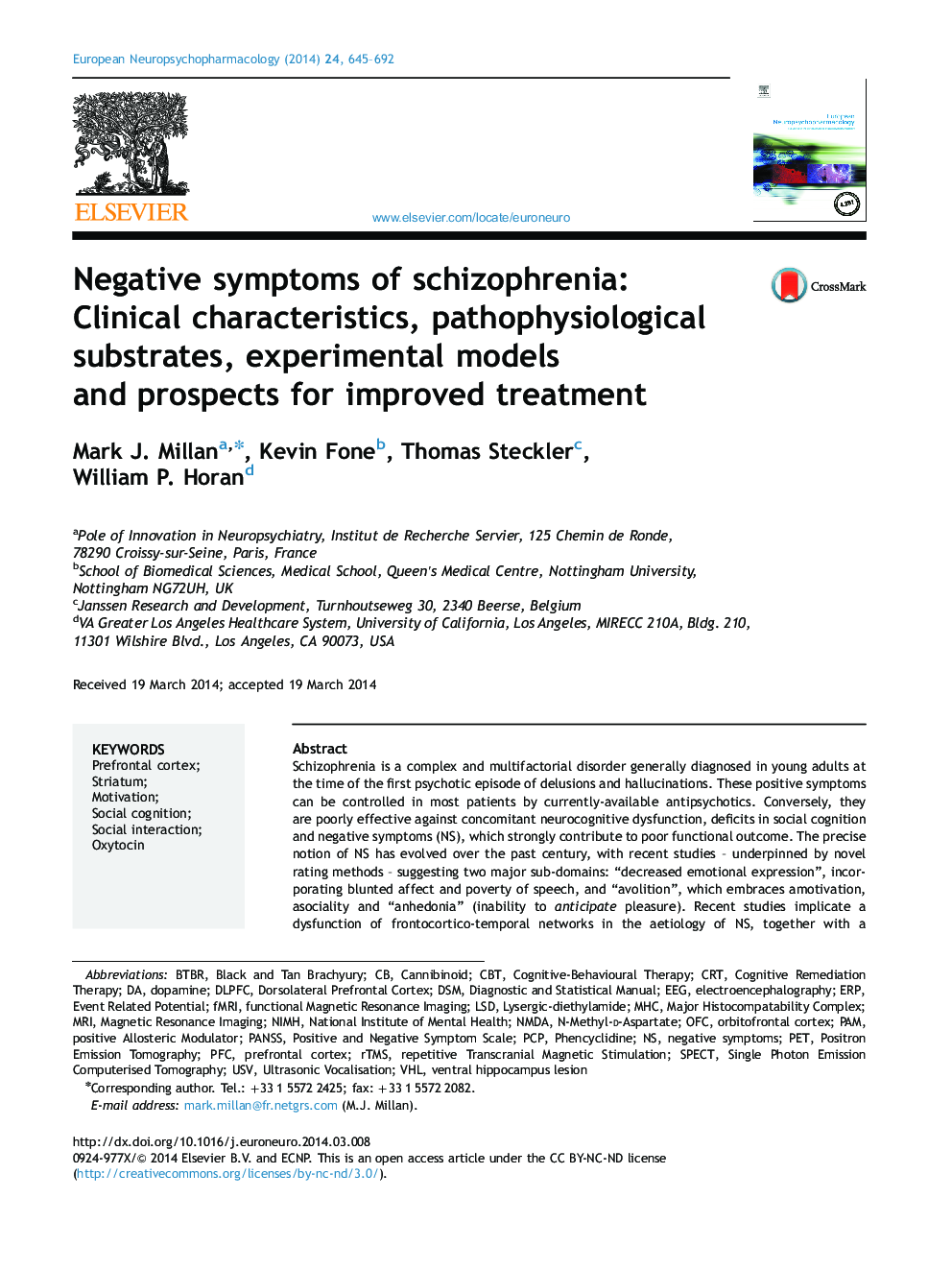| کد مقاله | کد نشریه | سال انتشار | مقاله انگلیسی | نسخه تمام متن |
|---|---|---|---|---|
| 10299011 | 539679 | 2014 | 48 صفحه PDF | دانلود رایگان |
عنوان انگلیسی مقاله ISI
Negative symptoms of schizophrenia: Clinical characteristics, pathophysiological substrates, experimental models and prospects for improved treatment
ترجمه فارسی عنوان
علائم منفی اسکیزوفرنی: ویژگی های بالینی، بستر پاتوفیزیولوژیک، مدل های تجربی و چشم انداز بهبود درمان
دانلود مقاله + سفارش ترجمه
دانلود مقاله ISI انگلیسی
رایگان برای ایرانیان
کلمات کلیدی
rTMSNMDAPCPN-methyl-d-aspartatePAMCrtDLPFCOFCPANSSUSVLSDDSMPFCVHLBTBRStriatum - استریاتومElectroencephalography - الکتروانسافالوگرافیMRI - امآرآی یا تصویرسازی تشدید مغناطیسیMotivation - انگیزشoxytocin - اکسیتوسینSPECT - برشنگاری رایانهای تک فوتونی، مقطع نگاری رایانهای تک فوتونی، توموگرافی رایانهای تک فوتونی، اسپکتERP - برنامه ریزی منابع سازمانRepetitive transcranial magnetic stimulation - تحریک مغناطیسی ترانس مغناطیسی تکراریMagnetic resonance imaging - تصویربرداری رزونانس مغناطیسیfunctional magnetic resonance imaging - تصویرسازی تشدید مغناطیسی کارکردیfMRI - تصویرسازی تشدید مغناطیسی کارکردیSocial interaction - تعامل اجتماعیSingle Photon Emission Computerised Tomography - توموگرافی کامپیوتری انتشار اتمی فوتونPositron emission tomography - توموگرافی گسیل پوزیترونCognitive remediation therapy - درمان اصلاح شناختیCognitive-behavioural therapy - درمان شناختی-رفتاریDopamine - دوپامینDiagnostic and Statistical Manual - راهنمای تشخیصی و آماریCBT - رفتار درمانی شناختی Social cognition - شناخت اجتماعیUltrasonic vocalisation - صدای بلند سونوگرافیnegative symptoms - علائم منفیPhencyclidine - فن سیکلیدین، گرد فرشتهprefrontal cortex - قشر prefrontalorbitofrontal cortex - قشر اوربیتوفرنتالdorsolateral prefrontal cortex - قشر پیشانی غدد درون رحمیMajor histocompatability complex - مجتمع مهم histocompatabilityMHC - مجموعه سازگاری بافتی اصلیpositive allosteric modulator - مدولاتور آلوده کننده مثبتPositive and Negative Symptom Scale - مقیاس علائم مثبت و منفیNational Institute of Mental Health - موسسه ملی سلامت روانEEG - نوار مغزیNIMH - نیمهPET - پتevent related potential - پتانسیل مربوط به رویداد
موضوعات مرتبط
علوم زیستی و بیوفناوری
علم عصب شناسی
روانپزشکی بیولوژیکی
چکیده انگلیسی
Schizophrenia is a complex and multifactorial disorder generally diagnosed in young adults at the time of the first psychotic episode of delusions and hallucinations. These positive symptoms can be controlled in most patients by currently-available antipsychotics. Conversely, they are poorly effective against concomitant neurocognitive dysfunction, deficits in social cognition and negative symptoms (NS), which strongly contribute to poor functional outcome. The precise notion of NS has evolved over the past century, with recent studies - underpinned by novel rating methods - suggesting two major sub-domains: “decreased emotional expression”, incorporating blunted affect and poverty of speech, and “avolition”, which embraces amotivation, asociality and “anhedonia” (inability to anticipate pleasure). Recent studies implicate a dysfunction of frontocortico-temporal networks in the aetiology of NS, together with a disruption of cortico-striatal circuits, though other structures are also involved, like the insular and parietal cortices, amygdala and thalamus. At the cellular level, a disruption of GABAergic-glutamatergic balance, dopaminergic signalling and, possibly, oxytocinergic and cannibinoidergic transmission may be involved. Several agents are currently under clinical investigation for the potentially improved control of NS, including oxytocin itself, N-Methyl-d-Aspartate receptor modulators and minocycline. Further, magnetic-electrical “stimulation” strategies to recruit cortical circuits and “cognitive-behavioural-psychosocial” therapies likewise hold promise. To acquire novel insights into the causes and treatment of NS, experimental study is crucial, and opportunities are emerging for improved genetic, pharmacological and developmental modelling, together with more refined readouts related to deficits in reward, sociality and “expression”. The present article comprises an integrative overview of the above issues as a platform for this Special Issue of European Neuropsychopharmacology in which five clinical and five preclinical articles treat individual themes in greater detail. This Volume provides, then, a framework for progress in the understanding - and ultimately control - of the debilitating NS of schizophrenia.
ناشر
Database: Elsevier - ScienceDirect (ساینس دایرکت)
Journal: European Neuropsychopharmacology - Volume 24, Issue 5, May 2014, Pages 645-692
Journal: European Neuropsychopharmacology - Volume 24, Issue 5, May 2014, Pages 645-692
نویسندگان
Mark J. Millan, Kevin Fone, Thomas Steckler, William P. Horan,
